Connie Nordhielm Wooldridge's Blog
September 11, 2024
Hannah Coulter by Wendell Berry Reviewed by Connie Nordhielm Wooldridge…

 Hannah Coulter by Wendell Berry; Counterpoint, 2004. 186 pages; $16.95 (paperback); reading level: adult.
Hannah Coulter by Wendell Berry; Counterpoint, 2004. 186 pages; $16.95 (paperback); reading level: adult.
The year is 2001. Hannah Coulter is looking back on the seventy-nine years of her life, spent mostly in the fictional Kentucky town of Port William. In words that are both plain-spoken and elegant, she chronicles her childhood, the loss of her first husband in World War II, her long marriage to a second husband, the raising of children, the joys and heartaches of the community “membership” that keeps her small farm and others going, and, most poignantly, the inevitable changes that the passage of time brings. Berry has created a fully-imagined world here. A map of the Port William area and a genealogy of its families is appended; also included is a list of companion books Berry has written about other characters who are part of the “Port William Membership.” Through Hannah’s story, Berry brings old-fashioned principles to mind while avoiding the trap of legalistic certainty about the mysteries of life that are beyond understanding. This is one of the wisest books I have ever read.
—
Connie Nordhielm Wooldridge, Author Biography | View
Biography | View
Connie is an experienced speaker and presenter who enjoys sharing her passion for writing and her experience as a writer with readers and writers of all ages. She has presented to students, community, civic and professional organizations, writing groups, library audiences, and seniors – wherever book lovers gather!
>> More Information About Connie Speaking and Presenting
The post Hannah Coulter by Wendell Berry Reviewed by Connie Nordhielm Wooldridge… first appeared on Connie Wooldridge - Author.
August 28, 2024
This Is the Chance!; The Great Alaska Earthquake, Genie Chance, and the Shattered City She Held Together by Jon Mooallem Reviewed by Connie Nordhielm Wooldridge…

This Is Chance!; The Great Alaska Earthquake, Genie Chance, and the Shattered City She Held Together by Jon Mooallem; Random House, 2021. 315 pages; $18.00 (paperback); reading level: adult/young adult.
Beginning with the epigram (a quote from Thornton Wilder’s play Our Town) and a “Cast of Characters” followed by Acts One, Two, and Three (instead of a table of contents and chapters) it’s clear that this is something more than the usual disaster tale. The title misleads by giving part-time news reporter Genie Chance star billing. Though we do learn a lot about Chance’s life and her near-continuous radio broadcast that guided her adopted city of Anchorage through the second most powerful earthquake ever measured, Mooallem reaches for something more ambitious: Channeling the Stage Manager in Wilder’s Our Town (the very play whose opening at a makeshift Anchorage theater is aborted by the quake) author Mooallem zooms from a granular account of people’s actions during the disaster to a grand sweep of their backstories and deaths years (or sometimes mere weeks) after the quake. The author seems to be asking whether his subjects’ lives are infinitely precious as they reach out in the moment to help one another survive or depressingly meaningless as time sweeps their individual stories into the collective dustbin of history. For all the meticulous details Mooallem provides about the quake and its aftermath (and there are many), it is the juxtaposition of Wilder’s play (in which firm concepts such as time and place become unstable) and the Great Alaska Earthquake (during which solid ground folds, crumbles, and slides) that provides the closest sense of what survivors of the disaster might have felt. The book is far from perfect – it often feels as if it can’t remember where it’s going – but it illuminates some key ideas that will resonate long after the last word is read.
—
Connie Nordhielm Wooldridge, Author Biography | View
Biography | View
Connie is an experienced speaker and presenter who enjoys sharing her passion for writing and her experience as a writer with readers and writers of all ages. She has presented to students, community, civic and professional organizations, writing groups, library audiences, and seniors – wherever book lovers gather!
>> More Information About Connie Speaking and Presenting
The post This Is the Chance!; The Great Alaska Earthquake, Genie Chance, and the Shattered City She Held Together by Jon Mooallem Reviewed by Connie Nordhielm Wooldridge… first appeared on Connie Wooldridge - Author.
June 25, 2024
Everybody’s Book; The Story of the Sarajevo Haggadah by Linda Leopold Strauss Reviewed by Connie Nordhielm Wooldridge…
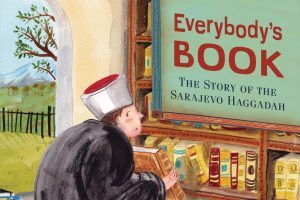
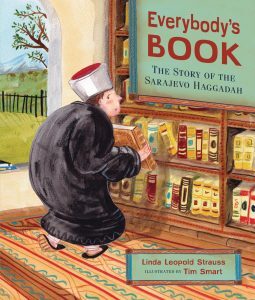 Everybody’s Book; The Story of the Sarajevo Haggadah by Linda Leopold Strauss; illustrated by Tim Smart; Kar-Ben Publishing/Lerner, 2024. 32 pages; $18.99 (hardcover); reading level: Grades 2-5.
Everybody’s Book; The Story of the Sarajevo Haggadah by Linda Leopold Strauss; illustrated by Tim Smart; Kar-Ben Publishing/Lerner, 2024. 32 pages; $18.99 (hardcover); reading level: Grades 2-5.
This true story begins in 1350, when a stunningly beautiful haggadah (a book that narrates the Jewish passover along with other Bible stories) is presented to a Spanish couple. Following the Spanish Inquisition, the book is spirited away to Italy and then, in 1874, to the National Museum in Sarajevo, Bosnia, where it is cherished as a treasure by the Catholics, Orthodox Christians, Jews, and Muslims who populate the city. Ensuring its survival becomes a mission shared by all these diverse groups over the decades to follow: In 1941, the Catholic museum director diverts the Nazis who come to steal it and the imam of a mosque hides it among some Islamic texts. In 1992, when war between Bosnia and Serbia breaks out, the Sarajevo Haggadah (as it came to be known) survives the bombing of the National Museum and is briefly brought out of hiding by the Muslim president of Bosnia for a Passover seder which includes Jewish, Christian Orthodox, Catholic, and Muslim religious leaders and is celebrated as war planes fly overhead. When the fighting ends, the United Nations donates money to restore the book that had become a symbol of “hope that kindness and understanding would be stronger than hate.” Smart’s illustrations depict serious historical events and capture the beauty of the haggadah, while remaining bright and child-friendly. Over six hundred years of history and an uplifting message are deftly packaged in these thirty-two pages. Truly a book for our day and time.
—
Connie Nordhielm Wooldridge, Author Biography | View
Biography | View
Connie is an experienced speaker and presenter who enjoys sharing her passion for writing and her experience as a writer with readers and writers of all ages. She has presented to students, community, civic and professional organizations, writing groups, library audiences, and seniors – wherever book lovers gather!
>> More Information About Connie Speaking and Presenting
The post Everybody’s Book; The Story of the Sarajevo Haggadah by Linda Leopold Strauss Reviewed by Connie Nordhielm Wooldridge… first appeared on Connie Wooldridge - Author.
March 15, 2024
Beethoven; A Life in Nine Pieces by Laura Tunbridge Reviewed by Connie Nordhielm Wooldridge…

Beethoven; A Life in Nine Pieces by Laura Tunbridge; Yale University Press, 2020. 276 pages; $39.00 (hardcover); reading level: adult.
Timed to appear for the 250th anniversary of Beethoven’s birth in 2020, this book’s fascinating structure drew me in. Each of the nine chapters centers on a work by Beethoven and focuses on “a theme that sheds light on the historical context…and on his personality.” Its concise length and publication by Yale – a press known for bringing large subjects within the grasp of lay readers – sealed the deal. I was all in…then found myself struggling to turn the pages. Though the selected pieces moved chronologically through Beethoven’s life and the themes addressed intriguing topics (Was he a political, as well as a musical, revolutionary? Who was his “Immortal Beloved”? Why did he fight so hard to win custody of his nephew from his brother’s widow?) the narrative flow suffered from lack of biographical detail, flashbacks and foreshadowing that left me unsure of where I was in time, and long digressions on the music that read like extended program notes. Tunbridge’s research is solid and she does manage to achieve her goal of humanizing Beethoven through insights that offset some of the stereotypic baggage he’s accumulated over the years. Additionally, there were plenty of delightful, startling tidbits (such as the emerging role of the conductor and Beethoven’s shrewd negotiations to make a living from his talent) that caused me to reexamine my admittedly hazy notion of both the composer and his time. Those with a musical background will undoubtedly enjoy the book; I wish the writing had made its subject more accessible to the uninitiated.
—
Connie Nordhielm Wooldridge, Author Biography | View
Biography | View
Connie is an experienced speaker and presenter who enjoys sharing her passion for writing and her experience as a writer with readers and writers of all ages. She has presented to students, community, civic and professional organizations, writing groups, library audiences, and seniors – wherever book lovers gather!
>> More Information About Connie Speaking and Presenting
The post Beethoven; A Life in Nine Pieces by Laura Tunbridge Reviewed by Connie Nordhielm Wooldridge… first appeared on Connie Wooldridge - Author.
January 2, 2024
Foster by Claire Keegan Reviewed by Connie Nordhielm Wooldridge…
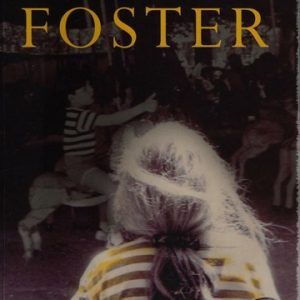
Foster by Claire Keegan; Grove Press, 2022. 92 pages; $20.00 (hardcover); reading level: adult/young adult.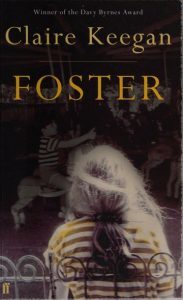
Originally published in Great Britain in 2010 (with a shortened version appearing in The New Yorker that same year), both a movie (under the title The Quiet Girl) and the book Foster finally appeared in the U.S. in 2022. The book was worth the wait. An unnamed narrator, a young girl of perhaps 7 or 8, tells the story of a small bit of her life as she struggles to make sense of it. She’s somewhere in the middle of a large Irish farm family and, when school lets out for the summer, is singled out to move in with her pregnant mother’s sister and husband in another town. She has to read the adult conversations around her to figure out all the things she’s not told: how long she will be away, whether her aunt and uncle have to scramble as hard as her own family to get by. She is utterly unprepared for the warmth and care lavished on her by her hitherto unknown relatives. When she returns home at the end of summer to her alcoholic father and hardened, hopeless mother, she has grown in every way imaginable. The question left hovering in the reader’s mind, as she lands right back where she started, is whether her expanded awareness is, in the end, a good thing. The answer (as with so many other answers to questions posed in this short gem of a book) is left to the reader to tease out. It’s the hints and insights hidden between the lines of Keegan’s text that make this book so rich and so deserving of a second or third read.
—
Connie Nordhielm Wooldridge, Author Biography | View
Biography | View
Connie is an experienced speaker and presenter who enjoys sharing her passion for writing and her experience as a writer with readers and writers of all ages. She has presented to students, community, civic and professional organizations, writing groups, library audiences, and seniors – wherever book lovers gather!
>> More Information About Connie Speaking and Presenting
The post Foster by Claire Keegan Reviewed by Connie Nordhielm Wooldridge… first appeared on Connie Wooldridge - Author.
November 21, 2023
Characters Julian Fellowes’ Gilded Age Gets Right: William Backhouse Astor, Jr.

 Caroline Astor’s husband, William Backhouse Astor, Jr., does not appear in Season 1 of The Gilded Age and that’s exactly why Julian Fellowes gets him right. Her husband preferred to be anywhere Caroline Astor wasn’t, which was a relief to Caroline because he tended to upset her perfectly orchestrated social events by treating guests rudely. He divided his time between Ferncliff (his country home on the Hudson), his yacht, and a place referred to by New Yorkers as “the fleshpots of Florida” where made investments and pursued disreputable women. The Astor marriage was a sham but it worked perfectly. Caroline gushed to friends about how good William was to her (meaning he gave her unlimited access to his fortune, which she employed to position his family at the very pinnacle of the social ladder) and visited Ferncliff just often enough to reassure the public that the couple was, in fact, still a couple. They remained married (happily, Caroline would insist, and no one dared contradict her) until William’s death in 1892.
Caroline Astor’s husband, William Backhouse Astor, Jr., does not appear in Season 1 of The Gilded Age and that’s exactly why Julian Fellowes gets him right. Her husband preferred to be anywhere Caroline Astor wasn’t, which was a relief to Caroline because he tended to upset her perfectly orchestrated social events by treating guests rudely. He divided his time between Ferncliff (his country home on the Hudson), his yacht, and a place referred to by New Yorkers as “the fleshpots of Florida” where made investments and pursued disreputable women. The Astor marriage was a sham but it worked perfectly. Caroline gushed to friends about how good William was to her (meaning he gave her unlimited access to his fortune, which she employed to position his family at the very pinnacle of the social ladder) and visited Ferncliff just often enough to reassure the public that the couple was, in fact, still a couple. They remained married (happily, Caroline would insist, and no one dared contradict her) until William’s death in 1892.
Note: The Gilded Age airs on Max.
Also in The Gilded Age Series of Posts Characters Julian Fellowes’ Gilded Age Gets Right: Caroline Astor Characters Julian Fellowes’ Gilded Age Gets Right: Mamie Fish—
Connie Nordhielm Wooldridge, Author Biography | View
Biography | View
Connie is an experienced speaker and presenter who enjoys sharing her passion for writing and her experience as a writer with readers and writers of all ages. She has presented to students, community, civic and professional organizations, writing groups, library audiences, and seniors – wherever book lovers gather!
>> More Information About Connie Speaking and Presenting
The post Characters Julian Fellowes’ Gilded Age Gets Right: William Backhouse Astor, Jr. first appeared on Connie Wooldridge - Author.
November 1, 2023
Brideshead Revisited; The Sacred and Profane Memories of Captain Charles Ryder by Evelyn Waugh Reviewed by Connie Nordhielm Wooldridge…
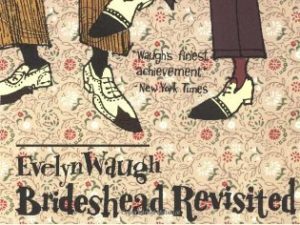
 Brideshead Revisited; The Sacred and Profane Memories of Captain Charles Ryder by Evelyn Waugh; (originally published in Britain, 1944); Back Bay Books, 2020. 402 pages; $17.99 (paperback); reading level: adult.
Brideshead Revisited; The Sacred and Profane Memories of Captain Charles Ryder by Evelyn Waugh; (originally published in Britain, 1944); Back Bay Books, 2020. 402 pages; $17.99 (paperback); reading level: adult.
In 1944, as Waugh’s magnum opus was going to press, he observed that Brideshead Revisited “is steeped in theology, but I begin to agree that theologians won’t recognize it.” At times, he even seems to be arguing against his adopted Catholic faith. His narrator, middle-class Charles Ryder, is an atheist—sorry, agnostic—student at Oxford, who is thrown into the midst of his new friend Sebastian’s aristocratic, Catholic family members, all wrestling with faith issues and none looking more saintly for the struggle. Charles often interacts with them at Brideshead, their lavish family estate—at its pinnacle in the 1920s and 30s. But the main action, which is set in those years, is framed by a prologue and epilogue in which Charles looks back on it all from World War II, when the crumbling Brideshead has been requisitioned to quarter his war-weary troops. Charles’ love for Sebastian—and for Sebastian’s sister Julia—pulls the story along and the writing is laced with wry humor, lush descriptions, insightful character insights and stylized prose perfectly in tune with the historical setting. But it is, indeed, the theology that drives the plot and faith that triumphs in the end. This is not a perfect novel: Charles and Julia’s first spouses are too-easily sent packing, characters move on and off stage at a dizzying pace, and Julia’s “outburst about mortal sin” (Waugh’s words) is overwrought. But these are small quibbles. The novel is well worth reading—or re-reading—even if you’ve seen the big- or small-screen adaptations.
—
Connie Nordhielm Wooldridge, Author Biography | View
Biography | View
Connie is an experienced speaker and presenter who enjoys sharing her passion for writing and her experience as a writer with readers and writers of all ages. She has presented to students, community, civic and professional organizations, writing groups, library audiences, and seniors – wherever book lovers gather!
>> More Information About Connie Speaking and Presenting
The post Brideshead Revisited; The Sacred and Profane Memories of Captain Charles Ryder by Evelyn Waugh Reviewed by Connie Nordhielm Wooldridge… first appeared on Connie Wooldridge - Author.
October 27, 2023
Characters Julian Fellowes’ Gilded Age Gets Wrong: Ward McAllister
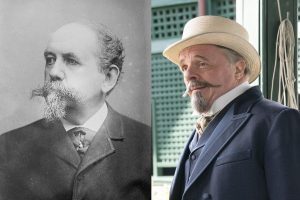
 In Season 1 of The Gilded Age, Ward McAllister appears to be a beneficent grandfather-figure who helps Bertha Russell after she’s been socially snubbed. A social climber himself who had gained entrance to High Society by ingratiating himself to Caroline Astor, McAllister did help the Vanderbilts, among others, into the same elite company he’d cajoled his way into. But he was viewed by society and the general public as pompous to the point of ridiculousness. Illustrator Charles Dana Gibson routinely lampooned him in Life magazine. When McAllister commented that “there are only about four hundred people in fashionable New York society,” a Gibson cartoon portrayed him as Mother Goose, dressed in an apron and bonnet, waving a banner proclaiming “The 400.” Behind him was a flock of geese—all wearing crowns. Caroline Astor finally grew so tired of McAllister’s posturing that she abandoned him completely.
In Season 1 of The Gilded Age, Ward McAllister appears to be a beneficent grandfather-figure who helps Bertha Russell after she’s been socially snubbed. A social climber himself who had gained entrance to High Society by ingratiating himself to Caroline Astor, McAllister did help the Vanderbilts, among others, into the same elite company he’d cajoled his way into. But he was viewed by society and the general public as pompous to the point of ridiculousness. Illustrator Charles Dana Gibson routinely lampooned him in Life magazine. When McAllister commented that “there are only about four hundred people in fashionable New York society,” a Gibson cartoon portrayed him as Mother Goose, dressed in an apron and bonnet, waving a banner proclaiming “The 400.” Behind him was a flock of geese—all wearing crowns. Caroline Astor finally grew so tired of McAllister’s posturing that she abandoned him completely.
Note: The Gilded Age airs on Max.
Also in The Gilded Age Series of Posts Characters Julian Fellowes’ Gilded Age Gets Right: Caroline Astor Characters Julian Fellowes’ Gilded Age Gets Right: Mamie Fish—
Connie Nordhielm Wooldridge, Author Biography | View
Biography | View
Connie is an experienced speaker and presenter who enjoys sharing her passion for writing and her experience as a writer with readers and writers of all ages. She has presented to students, community, civic and professional organizations, writing groups, library audiences, and seniors – wherever book lovers gather!
>> More Information About Connie Speaking and Presenting
The post Characters Julian Fellowes’ Gilded Age Gets Wrong: Ward McAllister first appeared on Connie Wooldridge - Author.
October 2, 2023
Characters Julian Fellowes’ Gilded Age Gets Right: Mamie Fish

 Like Caroline Astor, Mamie Fish was part of Old New York Society and looked down on the new-money climbers. When Mamie built a new home at 78th and Madison Avenue, she instructed the architect to create a ballroom that would make a person who was not well bred feel uncomfortable. Fellowes captures this aspect of her personality in the scene in which Mamie scowls down at Bertha Russell from behind the curtain of a second floor window after she’s instructed her butler to turn the interloper away. But Mamie also had a rebellious streak. While she made her required appearance at the opera, she claimed her favorite instrument was the comb. Her parties became wilder each year and boring was a thing she couldn’t abide. “Make yourself at home,” she once told a guest, “and believe me, there’s no one who wishes you there more heartily than I.” While Caroline Astor thrived on order and decorum, Mamie came to see society’s demands as stultifying. Fellows captures Mamie’s early, mischievous, fun-loving side when young Larry Russell visits her Newport home and is roped into playing games. Will Fellowes follow Mamie when—as a contemporary magazine put it—she leads society “out of the dull monotony of convention into the land of the
Like Caroline Astor, Mamie Fish was part of Old New York Society and looked down on the new-money climbers. When Mamie built a new home at 78th and Madison Avenue, she instructed the architect to create a ballroom that would make a person who was not well bred feel uncomfortable. Fellowes captures this aspect of her personality in the scene in which Mamie scowls down at Bertha Russell from behind the curtain of a second floor window after she’s instructed her butler to turn the interloper away. But Mamie also had a rebellious streak. While she made her required appearance at the opera, she claimed her favorite instrument was the comb. Her parties became wilder each year and boring was a thing she couldn’t abide. “Make yourself at home,” she once told a guest, “and believe me, there’s no one who wishes you there more heartily than I.” While Caroline Astor thrived on order and decorum, Mamie came to see society’s demands as stultifying. Fellows captures Mamie’s early, mischievous, fun-loving side when young Larry Russell visits her Newport home and is roped into playing games. Will Fellowes follow Mamie when—as a contemporary magazine put it—she leads society “out of the dull monotony of convention into the land of the
bizarre”?
Note: Season 2 of The Gilded Age begins October 29, 2023 on Max.
Also in The Gilded Age Series of Posts Characters Julian Fellowes’ Gilded Age Gets Right: Caroline Astor Characters Julian Fellowes’ Gilded Age Gets Right: Mamie Fish—
Connie Nordhielm Wooldridge, Author Biography | View
Biography | View
Connie is an experienced speaker and presenter who enjoys sharing her passion for writing and her experience as a writer with readers and writers of all ages. She has presented to students, community, civic and professional organizations, writing groups, library audiences, and seniors – wherever book lovers gather!
>> More Information About Connie Speaking and Presenting
The post Characters Julian Fellowes’ Gilded Age Gets Right: Mamie Fish first appeared on Connie Wooldridge - Author.
Oceans of Grain; How American Wheat Remade the World by Scott Reynolds Nelson Reviewed by Connie Nordhielm Wooldridge…
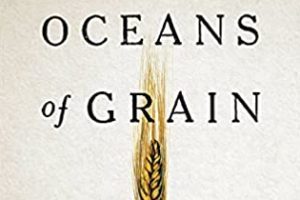
Oceans of Grain; How American Wheat Remade the World by Scott Reynolds Nelson. Basic Books, 2022. 356 pages; $32.00 (hardcover); reading level: adult.
by Scott Reynolds Nelson. Basic Books, 2022. 356 pages; $32.00 (hardcover); reading level: adult.
This is more a textbook than an informational read for a lay audience and requires those willing to soldier through it to bring a lot of knowledge to the table: a background in economics, finance, and Russian/U.S./European history (from 10,000 b.c. to 1924 a.d.) for starters. Nelson plucks a thread common to all of these disciplines and eras—pathways along which grain has been traded through the millennia—and makes the case that the age-old challenge of moving grain from fields to the mouths of citizens and soldiers is the driving force behind a host of historical events including the beginning of the concept known as “empire”, the siege of Constantinople, the rise of Russia under Catherine the Great, World War War I, the Bolshevik Revolution, and the end of slavery (in the U.S.) and serfdom (in Europe). Nelson’s lofty assessment of his audience’s prior knowledge more often than not left this particular reader struggling to hang on to the narrative thread. Mountains of supportive facts and frequent digressions pulled in all directions. Still, Nelson’s impressive command of the material, his outrageous thesis (intriguing if not convincing), and the tiny gems of information scattered along the way made the frequent slogs through (to me) incomprehensible territory almost worthwhile.
—
Connie Nordhielm Wooldridge, Author Biography | View
Biography | View
Connie is an experienced speaker and presenter who enjoys sharing her passion for writing and her experience as a writer with readers and writers of all ages. She has presented to students, community, civic and professional organizations, writing groups, library audiences, and seniors – wherever book lovers gather!
>> More Information About Connie Speaking and Presenting
The post Oceans of Grain; How American Wheat Remade the World by Scott Reynolds Nelson Reviewed by Connie Nordhielm Wooldridge… first appeared on Connie Wooldridge - Author.




